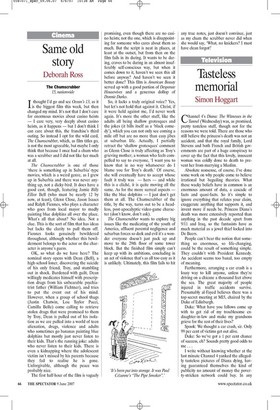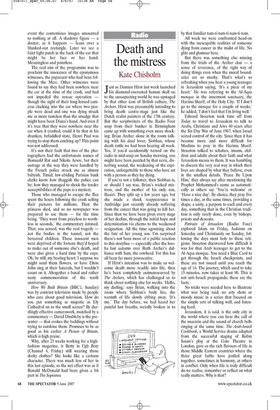Tasteless memorial
Simon Hoggart Channel 4's Diana: The Witnesses in the Tunnel (Wednesday) was, as promised, pretty tasteless stuff, though not for the reasons we were told. There are those who still believe the princess's death was not an accident, and that the royal family, Lord Stevens and both French and British governments are part of a huge conspiracy to cover up the fact that this lovely, innocent woman was coldly done to death to prevent her from marrying a Muslim.
Absolute nonsense, of course. I've done some work on why people come to believe irrational but beguiling theories. What these wacky beliefs have in common is an enormous amount of data, a cascade of facts and quasi-facts. So it's simple to ignore everything that refutes your claim, exaggerate anything that supports it, and invent more if needs be. Princess Diana's death was more extensively reported than anything in the past decade apart from 9/11 and Iraq, so the fantasists have as much material as a jewel thief locked into De Beers.
People can't bear the notion that something so enormous, so life-changing, could be the result of something simple. They couldn't with President Kennedy. An accident seems too banal, too empty of meaning.
Furthermore, arranging a car crash is a lousy way to kill anyone, unless they're driving on a chicane a thousand feet above the sea. The great majority of people injured in traffic accidents survive. Presumably al-Fayed believes there was a top-secret meeting at MI5, chaired by the Duke of Edinburgh.
Duke: What have you fellows come up with to get rid of my troublesome exdaughter-in-law and make my grandsons grieve for the rest of their lives?
Spook: We thought a car crash, sir. Only 99 per cent of victims get out alive.
Duke: So we've got a 1 per cent chance of success, eh? Sounds pretty good odds to me . . .
I write without knowing whether at the last minute Channel 4 yanked the allegedly tasteless pictures of Diana dying, having guaranteed themselves the kind of publicity no amount of money the poverty-stricken network could buy. In any event the contentious images amounted to nothing at all. A shadowy figure — a doctor, as it happens — leans over a blanked-out rectangle. Later we see a faint light patch in the back of the car that might be her face or her hand. Meaningless and pointless.
The real aim of the programme was to proclaim the innocence of the eponymous witnesses, the paparazzi who had been following the Merc. Other witnesses were found to say they had been nowhere near the car at the time of the crash, and had not impeded the rescue operation — though the sight of their long-lensed cameras clacking into the car where two people were dead and one was dying struck me as more tasteless than the smudge that might have been Diana's hand. And even if it's true that they were nowhere near the car when it crashed, could it be that in his drunken, befuddled state, Henri Paul was trying to stop them catching up? This point was not addressed.
It's not their fault that two of the photographers had the unfortunate names of Romuald Rat and Nikola Arsov, but their outrage at the way they were handled by the French police struck me as almost babyish. Timid, law-abiding Parisian bank clerks know how thuggish the police can be; how they managed to shock the tender susceptibilities of the paps is a mystery.
Those who managed to escape the flics spent the hours following the crash selling their pictures for millions. Then the princess died, and so no newspaper was prepared to use them — for the time being. 'They went from priceless to worthless in seconds,' the commentary intoned. That, you sensed, was the real tragedy — not the bodies in the tunnel, not the bereaved children. These innocent men were deprived of the fortune they'd hoped to make out of someone else's death, and were also given a hard time by the cops. Oh, be still, my beating heart. I suppose we might send them flowers, or have Elton John sing at their funerals, but I wouldn't count on it. Altogether a banal and rather nasty commemoration of the tenth anniversary.
How We Built Britain (BBC1, Sunday) was by contrast television made by people who care about good television. How do you put something as majestic as Ely Cathedral on to the small screen? By dazzlingly effective camerawork, matched by a commentary — David Dimbleby is the presenter — that evokes the buildings without trying to outshine them. Promises to be as good as his earlier A Picture of Britain, which is high praise.
Why, after 23 weeks working for a highfashion magazine, is Betty in Ugly Betty (Channel 4, Friday) still wearing those dorky clothes? She looks like a cartoon character. There was much less of her in this last episode, so the net effect was as if Ronald McDonald had been given a bit part in The Sopranos.





























































 Previous page
Previous page